 Heavy Cruisers built 1922-26: IJN Furutaka, Kako
Heavy Cruisers built 1922-26: IJN Furutaka, KakoWW2 IJN Cruisers:
Furutaka class | Aoba class | Nachi class | Takao class | Mogami class | Tone classTenryu class | Kuma class | Nagara class | Sendai class | Katori class | Agano class | Oyodo
Tsushima | Asama | Tokiwa | Yakumo | Izumo | Kasuga | Hirado
The First Japanese “washington” cruisers: The two heavy cruisers of the Furutaka class were the first cruisers built at home for the Imperial Japanese Navy after the Washington Treaty. They were characterized by of a continuous deck with recesses in order to simplify construction, save weight and favour speed. The choice of an artillery in six single turrets was also singular and merits an explanation.
This particular configuration was not really advantageous and the two ships were completely rebuilt in 1936-39, with twin turrets, and new superstructures and bridge plus six twin torpedo tubes banks either side instead of two quadruple banks, a catapult, anti-torpedo ballasts, better protection and AA, however with a tonnage jumping to 10,340 tons full loaded. Both the Furutak and Kako were very active from 1937 and the war with China but barely WW2 as both were sunk in 1942, in naval gunfire or by the old submersible S-44.

USN ONI recoigition plate. It is oddly incorrect, showing the late revised armament version with the old configuration of bridge.
Background and genesis of the design
To understand what led to this particular design and the gap towards the WW1 era generation of cruisers, the Kuma, Nagara and Sendai classes, one needs to see the mood and ideas, concepts rocking the IJN admiralty at that time. First off, the 1912 Anglo-Japanese alliance was still active and vibrant, with strong ties between the Royal Navy officers and those from Japan, hence a competition for carriers, Hosho vs Hermes. For cruisers too, Japanese observers had two example classes under the eyes, just completed, the Enteprise class but more so, the Hawkins class, first RN heavy cruisers with 8-in guns.
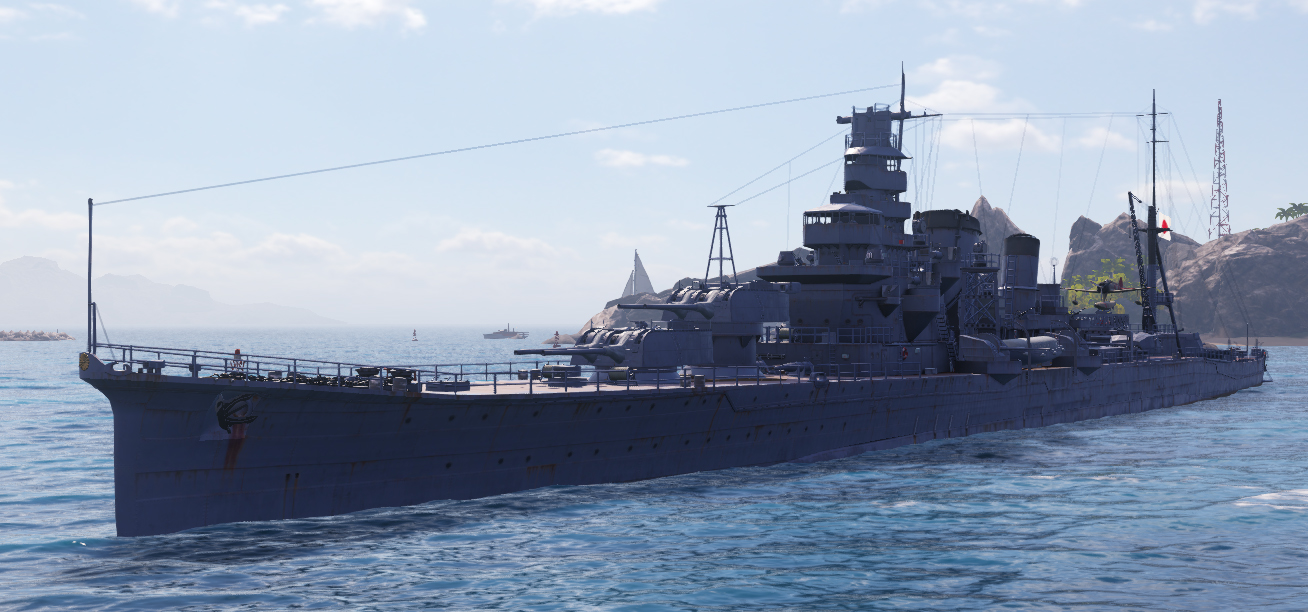
wow’s rendition of IJN Furutaka, as rebuilt
When the Washington treaty was signed, the IJN had to scrap the three last Nagara-class ships, Minase, Otonase and an unnamed ship. The latter were still in stright line derived from the Tenryu in 1918, four-pipers armed with a collection of single 6-in guns and intended as flotilla leaders for destroyers. They were fast, but weakly protected, barely 5200 tonnes standard. The Furutaka were known at first as the “A class” cruisers, authorized in the 1922 naval plan alongside the Yubari, under the responsibility of chief designer, constructor Captain Yuzuru Hiraga, assisted by Lt. Cmdr. Kikuo Fujimoto. Quite simply the Sendai were not on par with the latest western cruisers, the Omaha class and the British Hawkins-class. Having some constrains still, the chief designer choosed to make compromised ship, just as as fast as the Omahas but faster than than the Hawkins class by 4 knots, while hvaving a heavier broadside, and larger torpedo battery. Using 8-in guns was already a radical departure, but having all these in the axis allowed to maximise broadside arc of fire.
About the designer, Yuzuru Hiraga
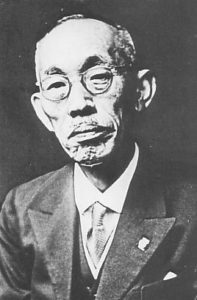 Maintaining a very high speed with this heavier armament imposed drastic design choices, extreme weight-saving measures. As a result the ships needed to pack six 20 cm (7.9 in) guns on a 7,000 tons displacement. The ships were designed by Baron Yuzuru Hiraga. Doctor of Engineering, he became the head of the engineering school of Tokyo Imperial University. He was formed at the Royal Naval College, Greenwich and also visited yards in France and Italy in 1905-1908.
Maintaining a very high speed with this heavier armament imposed drastic design choices, extreme weight-saving measures. As a result the ships needed to pack six 20 cm (7.9 in) guns on a 7,000 tons displacement. The ships were designed by Baron Yuzuru Hiraga. Doctor of Engineering, he became the head of the engineering school of Tokyo Imperial University. He was formed at the Royal Naval College, Greenwich and also visited yards in France and Italy in 1905-1908.
Later made an admiral, he designed many IJN warships before and after WW1, most if which saw service during the second world war, like the Kongo and Fuso class battleships. He was appointed a technical advisor to the Japanese delegation at the Washington Naval Conference, and became the head of the Imperial Japanese Navy Technical Department at his return. He respected the treaty terms and advocated for brand new ships in conformity with the treaty. By making them extremely powerful on a limited dislacement, using many innovations in the process, making his designs among the most advanced in the world.
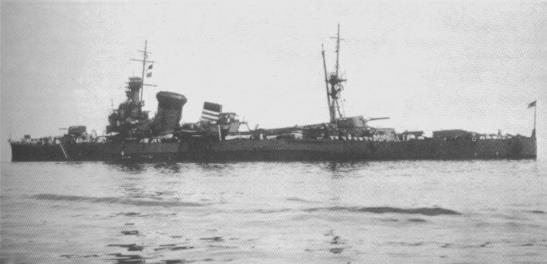
IJN Kako at Kure 1928
Hiraga made a superb example of this with the Furutaka class, the first of a long serie of treaty-compliant cruisers which were crammed with armaments but in the end not only cheated with tonnage announcements, but made many sacrifices in the process (notably protection). Japanese steel certainly constributed to this. It was one of the world’s strongest, allowing to reduce armor thicknness, which combined to their integration in the structure and welding, save weight.
Quite often and surprisingly enough, the Imperial Japanese Navy General Staff proved bolder and imposed an heavier armament, like the 8,000 tons Mogami class, which surclassed all the ‘London-cruisers’ of the late 1930s. He was only discredited from 1934 after the loss of the TB Tomozuru, being accused of designing ships top-heavy, tending naturally towards instability and somewhat flimsy.
Furutaka class design
The first measure was to design a complete flush deck, unlike previous ships, resulting in weight savings and increasing strength. Indeed the hull’s longitudinal members could now run all along. Like for the innovative Yūbari, the side and deck armour were integrated into the ship’s structure, which also was weight-saving. Despite of this the heavy armament still claimed 900 tons overweight compared to the blueprints and specs. The draft augmented from a metre and top speed was reduced while the belt armour was much reduced above the waterline, making the ship vulnerable to plunging fire. Portholes of the two crew quarters needed as a result to be closed and maintained shut when the ships were at sea.
This reduced ventilation, making the living spaces stinky and wet. There were three angles on the hull. One at the bow, with a raised prow, and a drop under the torpedo tubes banks, down in a smooth curve to the stern. Therefore deck space in this area was slightly angled. Also the long and relatively narrow hull was pierced by six turret barbettes, three at the front and three at the rear, weakening decks and allowing some dangerous twisting of the hull. By the new standard they imposed, the Furutaka led to the Aoba, barely larger, but improved.
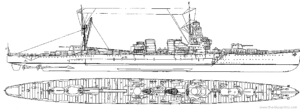
Blueprint of the Furutaka as built in 1926.
Powerplant
The Fututaka and Kako were propelled by four shafts mated to four geared steam turbines, fed by mixed coal/oil-fired 12 Kampon boilers, rated for 102,000 shp (76,000 kW). Top Speed as a result of the 9500 tons hull fully loaded was 34.5 knots (63.9 km/h; 39.7 mph). These ships were very narrow to achieve such speed in fact: The hull was 185.1 m (607 ft 3.4 in) long overall, for a beam of only 16.55 m (54 ft 3.6 in), so almost a 1/11 ratio. Draught was 5.56 m (18 ft 2.9 in) so the roll was potentially heavy, as shown later, and agility poor. Range was 6,000 nautical miles (11,000 km; 6,900 mi) at 14 knots (26 km/h; 16 mph).
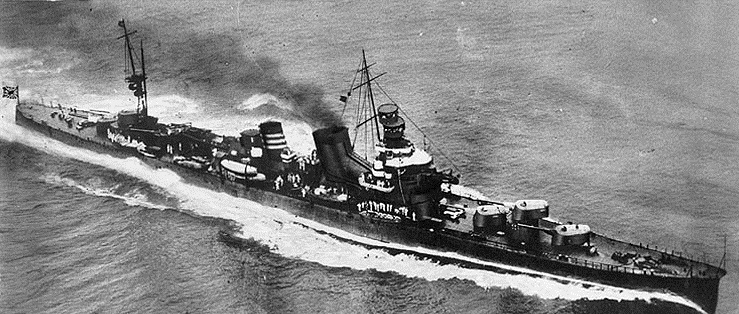
IJN Kako at full speed in Tokyo Bay, 1928
Protection
Reaching a high speed imposed many sacrifices and these cruisers were a bit like Italian “paper cruisers”, with a symbolic protection, while the armor was welded and integrated into the structure, this make it stronger but also there was no layered effects to disrupt rounds energy. The ship’s belt was 76 mm (3 in) thick, magazines were protected by an armoured box 51 mm (2 in) thick, while the six main turrets had 25.4 mm (1 in) for frontal armor, far less than the main caliber (8-in). The conning tower, amazingly enough, had not armoured walls at all. The protective deck above the belt received a modest layer of 35 mm (1.4 in) while the two upper decks were 48 mm (1.9 in) thick.
Armament
The initial armament was still in line with previous cruisers, a collection of single guns, but of a superior caliber of 200 mm (7.9 in). This was not the standard 8-in (203 mm) but very close. The unusual fact was the fact these turrets were placed in a forward superfiring position (‘A’ and ‘B’), with a reverse ‘C’ turret forward of the main bridge. The X, Y and Z turrets were at the rear, ‘X’ was placed before the main mast aft, facing foward, and the singular airplane takeoff platform. ‘Y’ and ‘Z’ were placed after the mainmast in superfiring positions. This configuration as said above, weakened the deck strenght and emphasised broadside fire.
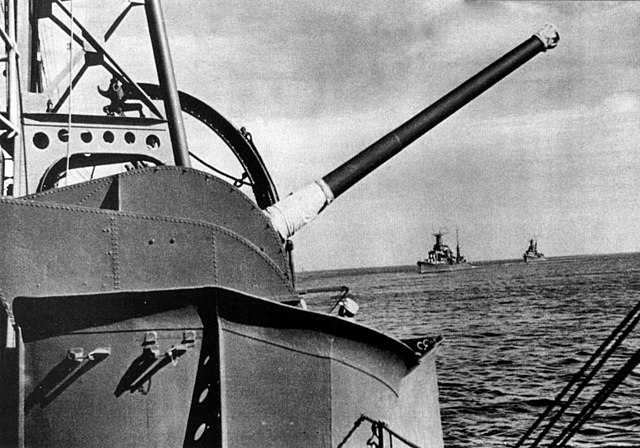
120mm/45 10th Year Type gun of the Imperial Japanese Navy in the single mount B2 Model on board of heavy cruiser Kako. This is no. 2 mount (forward, port), looking aft. Behind 120mm mount there’s part of lattice tower of the 110cm searchlight and davit. In background are heavy cruisers Furutaka (middle) a Kinugasa (right). Picture was taken after 1937 refit in years 1939-1942. Wikimedia cc from Imperial Japanese Navy via WIŚNIEWSKI, Piotr; BRZEZIŃSKI, Sławomir. Japoński ciężki krążownik Furutaka. Wyszków : BS, 2002. (Profile Morskie; sv. 46.)
The secondary armament was limited to four single 76.2 mm (3 in) AA guns, the standard of the time for anti-aircraft and close quarter artillery. In the 1930s it was already obsolete. These ships however also carried amazingly six twin 61 cm (24 in) torpedo tubes in fixed hull pairs either side. This arrangement draw attention and questioned the soundness of Hiraga’s choice. He will explain these due to the high freeboard of these ships. Standard deck torpedo tubes banks not only would have caused the torpedoes to enter the water too steeply, and their weight compromising even more stability.
So he choose to place them on the middle deck, also expecting a broadside volley in battleline, a concept that was never validated. Captain Hiraga added that this also protected the launchers and torpedoes from a direct hit. Apparently the wartime action indeed made it right: IJN Furutaka as rebuilt has standard deck TT banks, which were hit during the battle and detonated. The Cruisers Mikuma, Suzuya, Mogami, and Chōkai featured similar arrangements and were all sunk or severely damaged by their own exploding torpedoes.
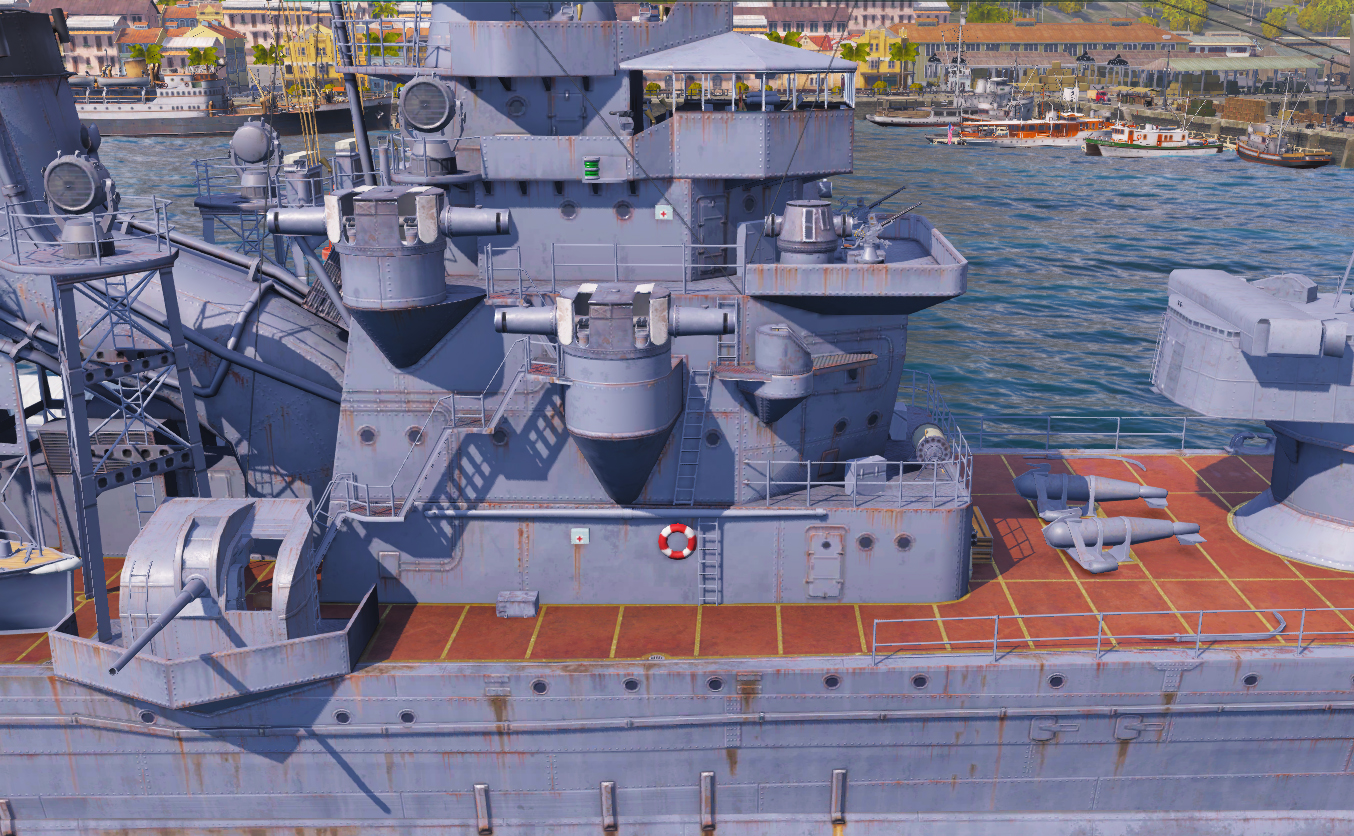
Details of the bridge on the IJN Furutaka as rebuilt (wow’s rendition closeup)
Modernizations of 1933 and 1939
The background behind both A class cruisers reconstruction was to be found in intensive naval exercises, in particular night tiorpeo attacks developed by the IJN in a context of a conflict with the USN in the pacific. Japanese naval strategists in particular focused on their superior long-range torpedoes to offset the USN numerical superiority. In 1930, the London Naval Treaty triggered in addition plans for an extensive modernization program, barely after a few years of service. This included radical upgrades in weapons, protection, fire control systems and communication. It was recognised their main artillery arrangement was not versatile enough, notably in chase and retreat, and AA artillery was deficient to say the least.
The first modernization in drydock took place from 1931 to 1933. In this first phase, they received a new AA armament, improved 12 cm high-angle electro-hydraulically operated guns assisted by their dedicated directors and range finders. Also the take-off platform was replaced by a proper catapult for a reconnaissance seaplane.
The second modernization in drydock took place in 1936-1937 for the Kako and 1937-1939 for the Furutaka and was quite extensive, it was a full reconstruction:
First off, the 6 single 7.87 in (200 mm) were disposed of and replaced by three modern twin turrets with standard 8 in (203 mm)/50-cal guns. Rate of fire, new breech-blocks, mountings with better elevation and better ammo elevators made them way more efficient in all directions and allowed to strengthen the decks.
Light anti-aircraft active protection was enhanced by adding eight 25 mm automatic cannons, in four twin mounts. Lastly, the hull-mounted pairs of TTs made for a classic broadside line of battle were deleted as the new staff privileged more aggressive tactics. Therefore two quadruple TT mounts were used instead, to fire the famous “long lance” Type 93 torpedo on the upper deck, either side of the catapult.
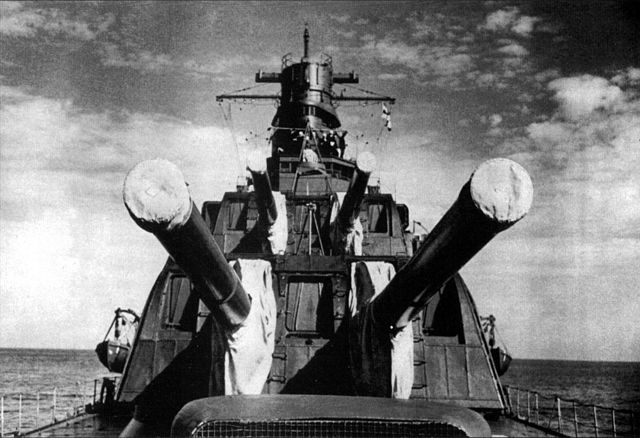
Main guns of IJN Kako after reconstruction
The other major change was the bridge structure, totally rebuilt, more angular. The goal was also to better support the latest rangefinders and fire control systems, tailored for the new main battery. Other directors were used for light AA artillery and torpedoes. Added platforms were redesigned also for aircraft spotters and powerful light projectors used for night fighting.
Under the armored belt, there were many other changes as well: The original mixed-fuel boilers were replaced by less (ten instead of 12) more larger and more efficient oil-fired boilers. The boiler rooms were also rebuilt and protection revised while the replacement of coal bunkers by fuel-oil tanks allowed to increase the range thanks to free space.
The new equipment, directors, rangefinders and armament was also power hungry and need a radical increased in electrical power. For this, three more generators were added and the output more than doubled from 315 kW to 885 kW. Protection however was not fundamentally revised. Both ships were still counting on their speed to compensate for their weaknesses.
In all, these modifications had a weight penalty, adding 560 tons to the ships. Significantly, bulges were added to improve stability and limit the draft, while anti-torpedo protection was also revised, resulting in a beam increased to 16.92 m (55.5 ft).
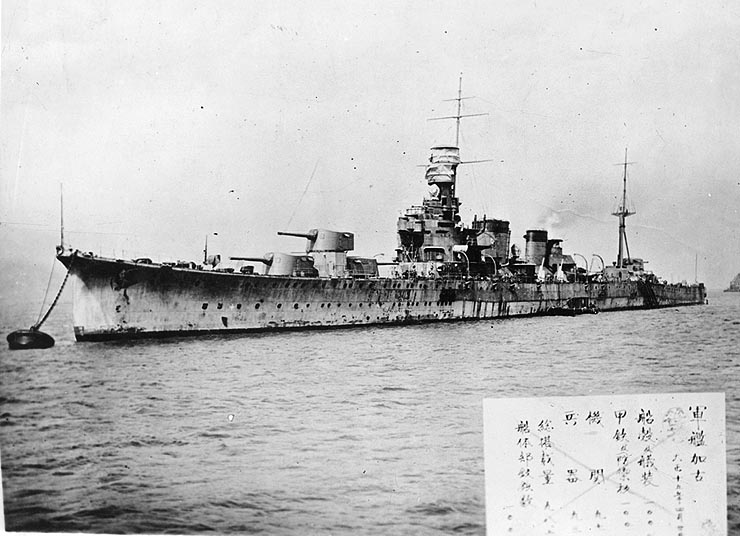
IJN Kako in 1926
They participated very actively in the Japanese operations, particularly in the Solomon Islands, and were both sunk, the Furutaka off the island of Savo, Guadalcanal, during the battle of Cape Hope the night of October 11 to 12, 1942, being part of the “Tokyo Night Express”, by the cruisers of Admiral Scott, but in reality she lost to a gunfight opposing her to the destroyer USS Duncan (DD-485), a Benson-class unit. This further made obvious her lack of protection as the similar fate she suffered compared to the Italians. IJN Kako was torpedoed and sunk near Kiaveng (New Britain) by the old American submarine S44, August 10, 1942, showing her ASW protection was far from sufficient either.
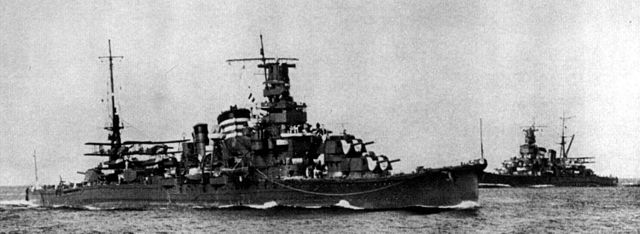
IJN Furutaka and Kinugasa of Cruiser Division 6 in the fall of 1941
IJN Furutaka
Interwar career saw IJN Furutaka initially assigned to Cruiser Division 5, remained until she was reduced to reserve in December 1931 and refitted at Kure Naval Base in 1932-33. Outside the new 4.7 inch she was given a catapult to launch the new E4N2 spotter floatplane. As recommissioned, she joined the Cruiser Division 6. Fleet exercises multiplied until she was taken in drydock again for a major reconstruction starting in April 1937. The old original guns were re-bored to 8 inch and the new mountings allowed 55° elevation, for AA fire if needed and increased range. Facilities were also upgraded, allowing to operated two E7K2 floatplanes. The overhaul of machinery also had some advantages. Keels were installed to compensate for top weight, improved stability, but it remained futile, the problem persisted.
Wake and Guam
At the time of the impending attack on Pearl Harbour, IJN Furutaka was sent again to the Cruiser Division 6, commanded by Rear Admiral Aritomo Goto. Part of the First Fleet, it also comprised the cruisers Aoba, Kako and Kinugasa. The division in December was engaged in support for the invasion of Guam. Due to the failure at Wake (first wave), Cruiser Division 6 was sent to a second, larger invasion force. Wake eventually fell and the division returned to the forward base at Truk in the Caroline Islands.
Marshall and the Solomons
By January 1942, Cruiser Division 6 supported Japanese landings at Rabaul, in New Britain and in Kavieng, New Ireland. The cruiser division also patrolled around the Marshall Islands in an attempt to catch the American fleet. By March–April 1942, Cruiser Division 6 supported the Cruiser Division 18, covering the landings in the Solomon Islands, New Guinea (Buka), Shortland, Kieta, Manus Island and the Admiralty Islands, Tulagi. Each time they operated from their forward base at Rabaul. On 6 May 1942 off Shortland island, IJN Furutaka was attacked by four Boeing B-17, but only had several long-misses. The US Air force was not yet disillusioned in the idea of using versatile heavy bombers to attack ships.
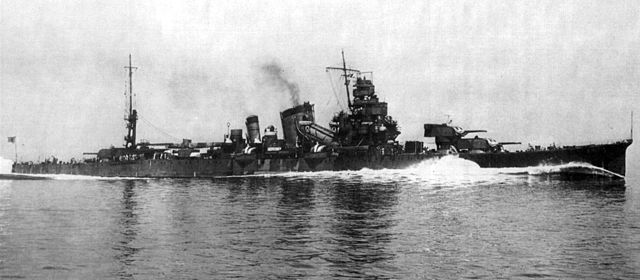
IJN Furutaka making her sea trials in 1939 (original)
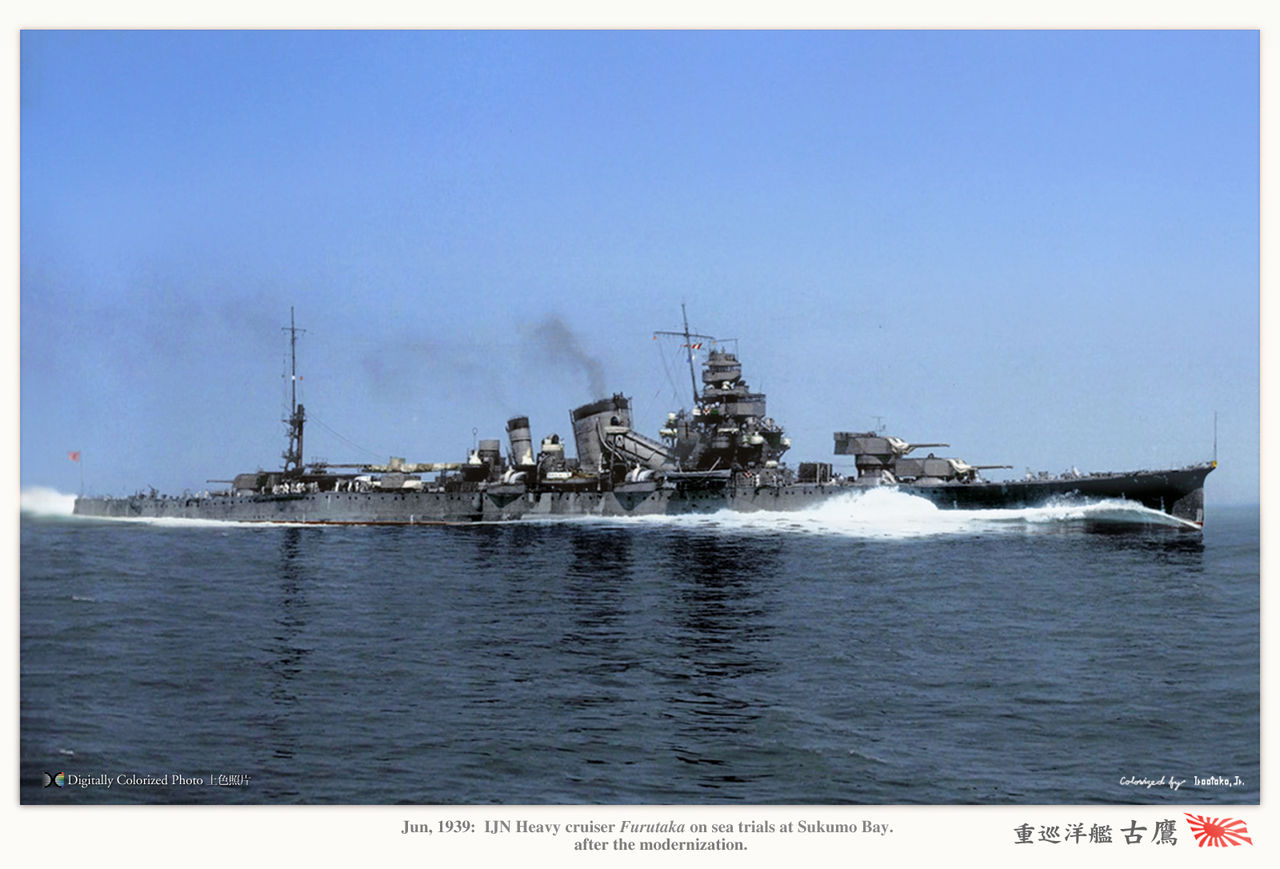
The same colorized by Hirootoko Jr. More of his photos
The battle of Coral Sea
Cruiser Division 6 sailed out from Shortland, meeting the light aircraft carrier Shōhō, escorting her. At 11:00, May, 7, 1942, north of Tugali Island, IJN Shoho met her fate. She was spotted and attacked by a squadrons of 93 Douglas SBD Dauntless dive bombers and Douglas TBD Devastator torpedo bombers. Both came from the USS Yorktown and Lexington aircraft carrier. Despite the skills of her captain and near-legendary evading manoeuvres, at the very edge of what the ship can endure, nothing could save the ship from the onslaught. She took several bomb hits and torpedo hits and eventually sank.
A day afterwards, 46 SBDs, 21 TBDs covered by 15 Grumman F4F Wildcats fighters took off from the same USS Yorktown and Lexington and badly damaged the IJN Shōkaku, badly hit on the waterline out of action, she was miraculously saved and retired for future repairs. IJN Furutaka and Kinugasa however covered IJN Shōkaku by their aggressive AA defence and escorted her limping back to Truk.
IJN Furutaka was back again on 5 June in Truk for repairs, and again on 7 July. On 14 July, she was assigned to the brand new Eighth Fleet (Vice Admiral Gunichi Mikawa), patrolling around the Solomon Islands, New Britain and New Ireland to prevent any USN reinforcements.
The battle of Savo Island
In the Solomons, there were planty of occasions to fight, as Marines stranded at Guadalcanal were not forgotten. The Battle of Savo Island was such as clash, on 9 August 1942. Cruiser Division 6, comprising the Chōkai, Tenryū and Yūbari, the destroyer Yūnagi made a bold night gun and torpedo attack. The next day one hour before midnight, 23:00, Chōkai, Furutaka and Kako launched their reconnaissance floatplanes, dropping flares illuminating targets allowing the Japanese to open fire first, sinking in one swoop the cruisers USS Astoria, Quincy and Vincennes while HMAS Canberra, badly damaged, was later scuttled.
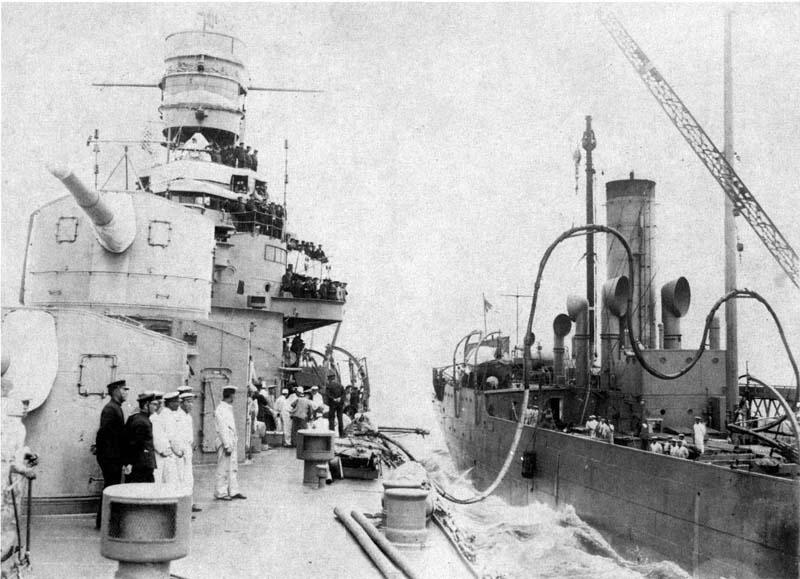
IJN Furutaka refuelling at sea alongside the gunboat Tsurumi.
The USS Chicago was damaged as well, destroyers USS Ralph Talbot and Patterson also, forced to retire. This was the worst USN defeat on the pacific since Pearl harbor. The Japanese only noted three hits on IJN Chōkai, two on IJN Kinugasa one on Aoba and none on Furutaka, back to Kavieng on 10 August.
By late August, Cruiser Division 6, reinforced by IJN Chōkai departed Shortland and covered a reinforcement convoy to Guadalcanal. Spotted by a PBY Catalina of VP23’s “Black Cats”, Furutaka was strafed and bomb, but missed. The Japanese cruiser later made a shuttle between Kieta and Rabaul to refuel and resupply. She was attacked en route on 12 September by the USN submarine S-47 south of New Ireland, but missed.
Death at Cape Esperance
IJN Furutaka met her fate in the Solomons, in a good old gunfight. The USS San Francisco, Salt Lake City, Boise, Helena equipped with radar and covered by five destroyers attempted to block the south entrance to Guadalcanal, setting an ambush near Savo Sound.
At 22:35, the 11 October 1942, USS Helena’s radar spotted the Japanese fleet. For once, the USN fleet was well prepared and crossed the Japanese “T”, giving them a crucial firepower.
Both fleets rapidly spotted each others and opened fire. Admiral Goto at first could not resolve the enemy was there and at first topped it, fearing friendly fire. But he soon ordered a 180-degree turn which fatally opened the line to American broadsides. IJN Aoba, Admiral Goto’s flagship was badly damaged and himself wounded. He soon died, leaving the squadron without command. Captain Araki of Furutaka decided to break the formation to engage engage the USS Salt Lake City. She was immediately torpedoed by the Destroyer USS Duncan, but missed. The latter engaged her in gunfight, hitting the Japanese cruiser ninety times with HE shells until she was partially disabled, set alight.

USS Duncan, which duelled and won against the Furutaka. She launched at her two volleys of torpedoes. Some allegedly hit but failed to explode at the first one. The second was more successful and stopped the cruiser dead in the water. In between she rained down some ninety 5-in HE hells on her, one or two hitting the torpedo tubes banks and setting her ablaze.
At 23:54, a torpedo hit flooded her forward engine room. But what proved the worst damage was the explosion of stockpiled Type 93 “Long Lance” torpedoes which really spread the fire to the ship. At 02:28, on 12 October, she sank, stern first. However Captain Araki and 514 survivors were rescued by the destroyers Hatsuyuki, Murakumo and Shirayuki. 115 were rescued by the Americans and became POWs, joining Featherston camp in New Zealand. The cruiser was discarded eventually on 10 November 1942. Her wreck was discovered on 25 February 2019 by RV Petrel, in a 600 m (2,000 ft) deep underwater valley, resting in two pieces, here bow broken off, laying on her port side, the rest sitting upright. The broken bow was another with Italian Guissano class cruisers.
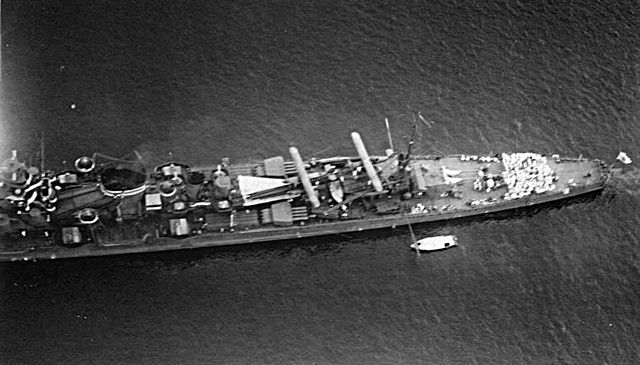
Stern overview, showing the torpedo tubes and their reloads, after reconstruction, IJN kako, November 1941
The IJN Kako
IJN was built by the Kawasaki Shipbuilding Corporation at Kobe, completed in 20 July 1926. She was part of the Fifth Squadron or ‘Sentai’ until 1933, patrolling Chinese waters, and combat operations off the China coast. She was refitted like her sister-ship in 1929–30, and operated with Cruiser Division 6 in 1933. She also displayed her full regalia in the Yokohama naval review, became a guard ship and was placed in reserve a year after. Reconstruction started in July 1936, before her sister, at Sasebo Navy Yard.
Work was complete in 27 December 1937. Changes were the same as Furutaka. Soon before 1942 started she was under command of Admiral Aritomo Goto, Cruiser Division 6, First Fleet, together with her sister ships, Aoba,and Kinugasa. She prepared for her first operation to Guam when the attack on pearl harbor took place.
She was part of the second invasion force and joined afterwards the forward base of Truk in the Caroline, and later Rabaul where she will return regularly between missions in 1942. By 18 January she supported the landings at Rabaul, in New Britain and at Kavieng. She later made patrols around the Marshall Islands.
Until late april she supported the cruiser division 18 for the Solomon Islands campaign, and participated also in the landings in New Guinea at Buka, Shortland, Kieta, Manus Island, the Admiralty Islands and Tulagi, this time operating from Raubaul. She was bombed bu missed by B-17 Flying Fortresses.
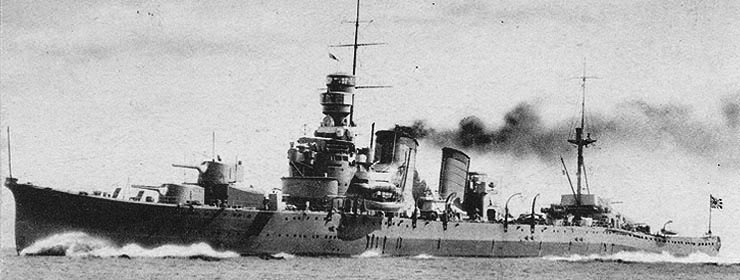
Battle of the Coral Sea
The cruiser division 6 sailed off Shortland and later met the carrier Shōhō to provided an encort. However on My 7 off Tulagi IJN Shōhō was sunk by waves of airplanes from USS Yorktown and Lexington and IJN Kako could only oppose little resistance of efficent cover. The following day the Shōkaku was severely bombed too but Kako escorted her back to base in Truk. Kako and Aoba also covered the convoy back from Port Moresby.
On 9 May however she stranded on a reef entering Queen Carola Harbor. Back to Kure Naval Arsenal on 22 May, she emerged on 23 June. She sailed to Rekata Bay in Santa Isabel Island. On 14 July 1942 her unit became the Eighth Fleet and she found in patrols around the Solomon Islands, New Britain and New Ireland.
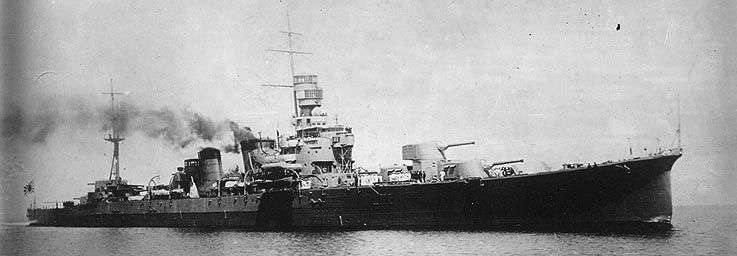
Battle of Savo Island
On 8 August 1942, her Aichi E13A1 “Jake” reconnaissance floatplane was shot down by an SBD Dauntless from USS Wasp, lke a prelude to the Battle of Savo Island. The next day, Aoba, Kako, Furutaka and Kinugasa plus the Chōkai and Tenryū and Yūbari and the destroyer Yūnagi attacked the USN fleet by night.
Floatplanes dropped flares, illuminating the targets and the result was that the USS Astoria, Quincy, Vincennes and HMAS Canberra were sunk, USS Chicago badly damaged, and destroyers Ralph Talbot and Patterson. Kako herself concentrated on the New Orleans class USS Vincennes, setting fire to her hangar and destroying her Curtiss SOC Seagulls. Kako emerged without a scratch frm the fight. This was a tremendous success.
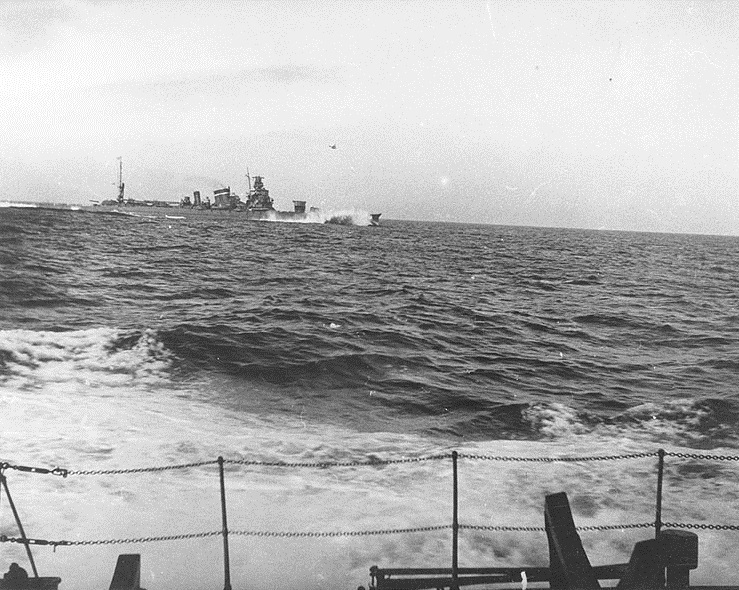
IJN Kako seen from another ship in 1940
On 10 August she escorted a convoy to Kavieng. At 06:50 however, the American submarine USS S-44 spotted the division 6 at 900 yards (800 m). Soon the veteran submarine (built in 1921) fired four Mark 10 torpedoes at about 700 yards (600 m). She targeted the last ship in line, IJN Kako. The first torpedo hit just below No. 1 turret starboard. Other torpedoes hit around the forward magazines and first boiler rooms.
By then Kako had her lowest portholes open which only aggravated the list. She capsised in just 5 minutes, exploding when seawater rushed on her red hot boilers and was gone at around 07:15 off Simbari Island. Captain Takahashi and most of the crew were saved by ther cruisers, but the ship had lost 34 crewmen. After the information reached the general HQ the Navy stuck her from the list on 15 September 1942.
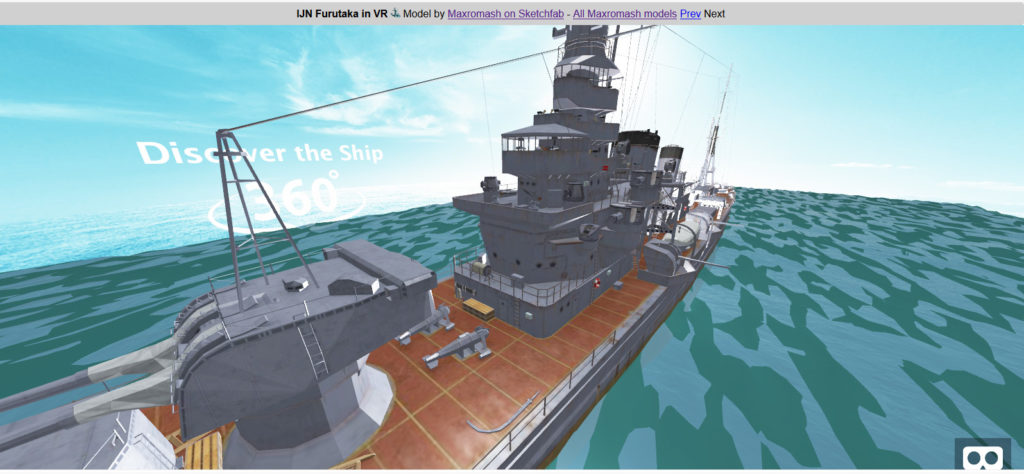
3D rendering by maxromash of the Furutaka in 1942 in WebVR
Specifications
Displacement 8 700 t. standard -10 340 t. Pleine Charge
Dimensions 183,53 m long, 19,93 m large, 5,61 m de tirant d’eau
Propulsion 4 propellers, 4 turbines, 12 boilers, 102 000 hp, 33 knots
Armor: 25 to 76 mm
Armament: 6 x 152 (3×2), 4 x 120, 8 x 25 AA, 4 x 13.2 mm HMG AA, 8 x 610 mm TTs (2×4), 2 seaplanes
Crew: 730

HD illustration of the Furutaka in 1941 by the author, 1/200
Sources/Read More
Lacroix, Japanese Cruisers, p. 307, 794
Bob Hackett, Sander Kingsepp (1997). “JUNYOKAN!”.
Japanese Navy Ships at history.navy.mil.com.
//www.combinedfleet.com/kako.htm
//www.fr.naval-encyclopedia.com/2e-guerre-mondiale/nihhon-kaigun.php#crois
en.wikipedia.org/wiki/Furutaka-class_cruiser
Conway’s all the worlds fighting ships 1921-1946
https://www.google.com/search?client=firefox-b-d&q=model+kits+furutaka

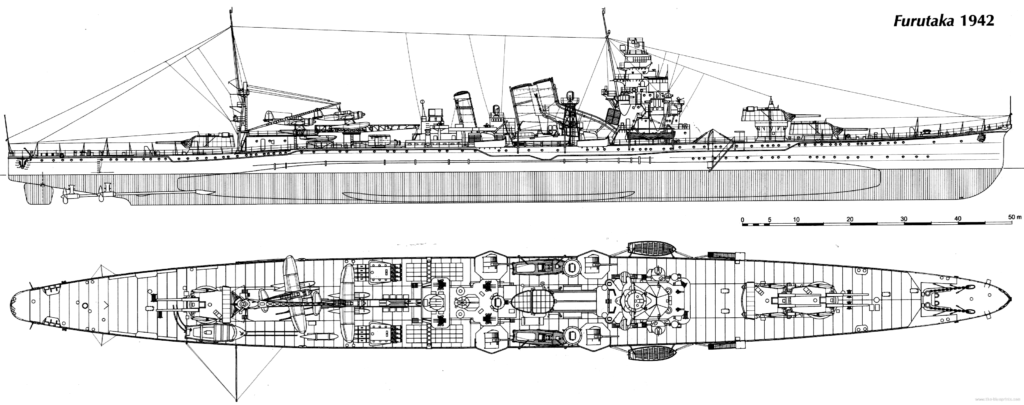
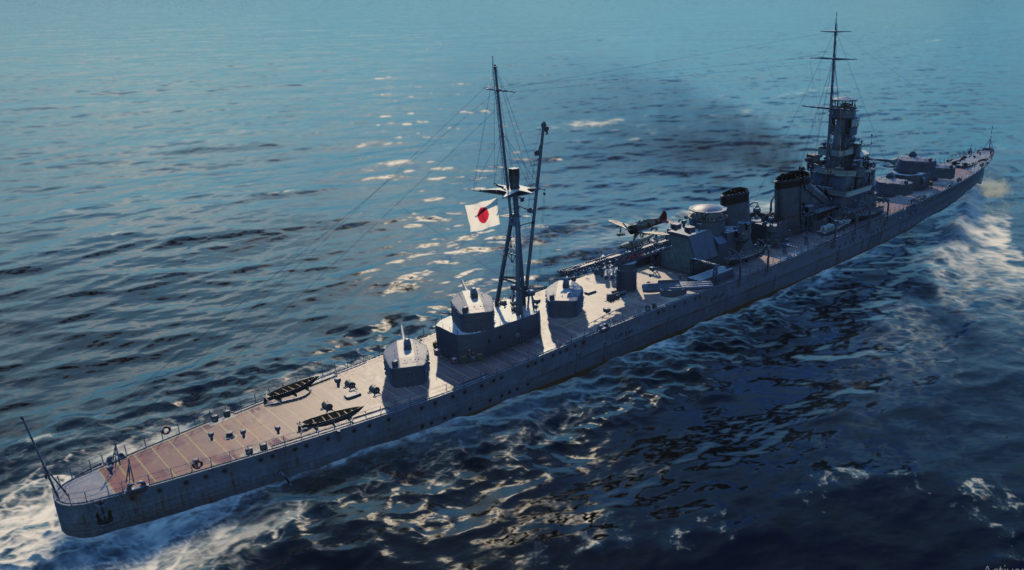
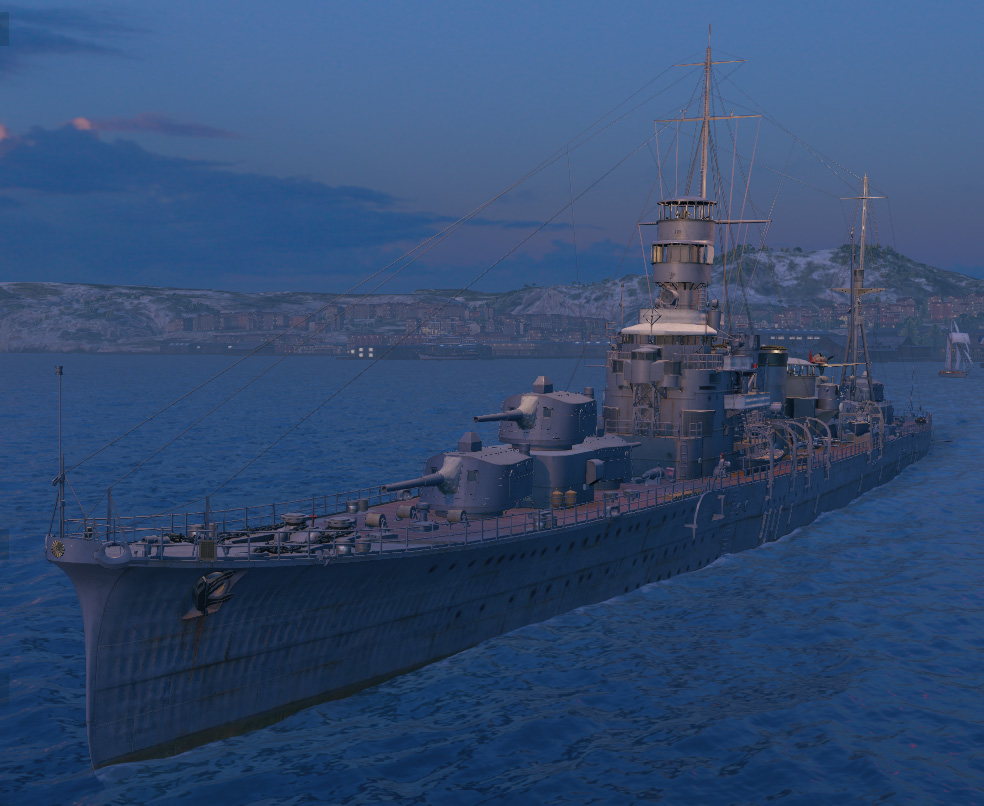
 Latest Facebook Entry -
Latest Facebook Entry -  X(Tweeter) Naval Encyclopedia's deck archive
X(Tweeter) Naval Encyclopedia's deck archive Instagram (@navalencyc)
Instagram (@navalencyc)





 French Navy
French Navy Royal Navy
Royal Navy Russian Navy
Russian Navy Armada Espanola
Armada Espanola Austrian Navy
Austrian Navy K.u.K. Kriegsmarine
K.u.K. Kriegsmarine Dansk Marine
Dansk Marine Nautiko Hellenon
Nautiko Hellenon Koninklije Marine 1870
Koninklije Marine 1870 Marinha do Brasil
Marinha do Brasil Osmanlı Donanması
Osmanlı Donanması Marina Do Peru
Marina Do Peru Marinha do Portugal
Marinha do Portugal Regia Marina 1870
Regia Marina 1870 Nihhon Kaigun 1870
Nihhon Kaigun 1870 Preußische Marine 1870
Preußische Marine 1870 Russkiy Flot 1870
Russkiy Flot 1870 Svenska marinen
Svenska marinen Søværnet
Søværnet Union Navy
Union Navy Confederate Navy
Confederate Navy Armada de Argentina
Armada de Argentina Imperial Chinese Navy
Imperial Chinese Navy Marinha do Portugal
Marinha do Portugal Mexico
Mexico Kaiserliche Marine
Kaiserliche Marine 1898 US Navy
1898 US Navy Sovietskiy Flot
Sovietskiy Flot Royal Canadian Navy
Royal Canadian Navy Royal Australian Navy
Royal Australian Navy RNZN Fleet
RNZN Fleet Chinese Navy 1937
Chinese Navy 1937 Kriegsmarine
Kriegsmarine Chilean Navy
Chilean Navy Danish Navy
Danish Navy Finnish Navy
Finnish Navy Hellenic Navy
Hellenic Navy Polish Navy
Polish Navy Romanian Navy
Romanian Navy Turkish Navy
Turkish Navy Royal Yugoslav Navy
Royal Yugoslav Navy Royal Thai Navy
Royal Thai Navy Minor Navies
Minor Navies Albania
Albania Austria
Austria Belgium
Belgium Columbia
Columbia Costa Rica
Costa Rica Cuba
Cuba Czechoslovakia
Czechoslovakia Dominican Republic
Dominican Republic Haiti
Haiti Hungary
Hungary Honduras
Honduras Estonia
Estonia Iceland
Iceland Eire
Eire Equador
Equador Iran
Iran Iraq
Iraq Latvia
Latvia Liberia
Liberia Lithuania
Lithuania Mandchukuo
Mandchukuo Morocco
Morocco Nicaragua
Nicaragua Persia
Persia San Salvador
San Salvador Sarawak
Sarawak Uruguay
Uruguay Venezuela
Venezuela Zanzibar
Zanzibar Warsaw Pact Navies
Warsaw Pact Navies Bulgaria
Bulgaria Hungary
Hungary

 Bundesmarine
Bundesmarine Dutch Navy
Dutch Navy Hellenic Navy
Hellenic Navy Marina Militare
Marina Militare Yugoslav Navy
Yugoslav Navy Chinese Navy
Chinese Navy Indian Navy
Indian Navy Indonesian Navy
Indonesian Navy JMSDF
JMSDF North Korean Navy
North Korean Navy Pakistani Navy
Pakistani Navy Philippines Navy
Philippines Navy ROKN
ROKN Rep. of Singapore Navy
Rep. of Singapore Navy Taiwanese Navy
Taiwanese Navy IDF Navy
IDF Navy Saudi Navy
Saudi Navy Royal New Zealand Navy
Royal New Zealand Navy Egyptian Navy
Egyptian Navy South African Navy
South African Navy






























 Ukrainian Navy
Ukrainian Navy dbodesign
dbodesign